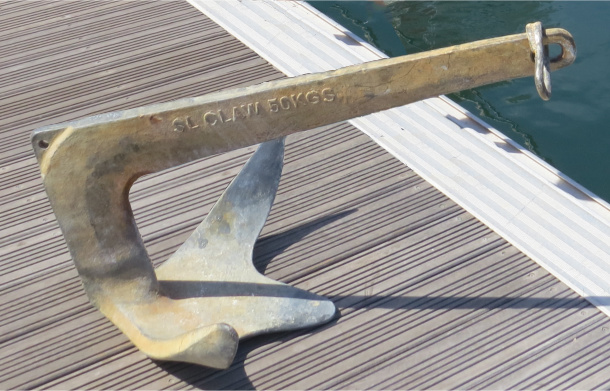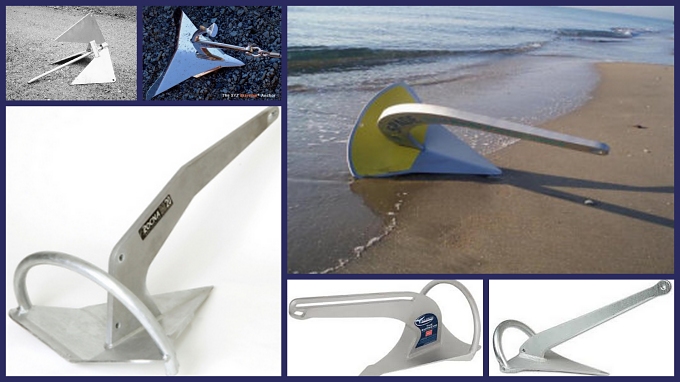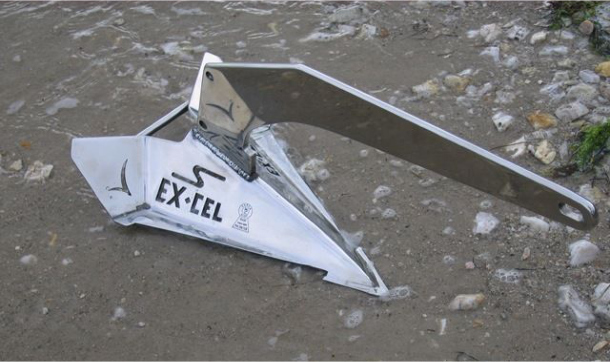The Blue View - In Search of the Perfect Anchor
/We have used a large Bruce anchor for the last 14 years. When we bought it, I did a lot of research on anchors and felt the Bruce, which is a claw or scoop type anchor, was the optimal anchor for us. I'm a firm believer that, all things being equal, a bigger anchor is always better than a smaller one, and we bought the largest anchor that would fit on our bow roller, all 50kg (110lb) of it, which is a couple of sizes larger than the recommended size for Nine of Cups.
In most bottoms, it sets well the first time, and the only problem we ever have is trying to get it unstuck when it is time to leave – a good problem, if ever there was one. In soft mud, it seems to drag very slowly when the wind pipes up – maybe 20 to 30 feet (6 to 9 meters) over the course of a day. It had difficulty in the heavy kelp we found in Patagonia and Tierra del Fuego, and we resorted to using two anchors in series and lines ashore to secure Cups at night. All anchors have difficulty in rock, and depend on wedging underneath, between or in some crevice of the rock to hold the vessel. Once hooked, it can be quite the exercise un-wedging the anchor. We almost had to leave our dependable old Bruce behind in a rocky anchorage in the Chatham Islands off New Zealand, before it finally came free.
Since we bought our Bruce, there have been a whole host of new anchors on the market, the Bugel, Rocna, Manson Supreme, Spade, and Bulwagga, to name a few, all of which claim to be much superior to the older designs. Over the years, we have been reasonably happy with our Bruce, however, and didn't feel compelled to change.
We will be cruising the south coast of Australia for the next couple of months, which is known for its deep grass combined with hard sand bottoms. Our Bruce, as well as many of the other common anchors like plows and CQRs, has problems digging into the sand under all that grass, and so we thought it was time to look at other anchors in the hopes of finding one that would hold well here, as well as perform well in most other bottom types.
A walk around any of the local marinas quickly made it apparent what the local yachties prefer. I'd estimate that 75% of them use a Marsh Stockless anchor as the anchor of choice in the grassy bottoms here. (Picture in your mind a miniature version of a traditional ship's anchor). While the stockless may do quite well in this area, however, it isn't the best all around anchor. The holding power for its weight is nowhere near as high in mud and soft sand as the newer design anchors, or the Bruce for that matter. To offset this, we would need to buy a very large version which is difficult to manage in our bow roller and is quite expensive. A 52 kg stockless anchor, the size recommended for Cups in strong winds would cost over $1000.
In the hopes of finding a good alternative to the stockless anchor, I spent a fair amount of time perusing the online forums and asking the local boat owners about their experiences with the various anchors, and I got a multitude of conflicting responses. Some swore by the new designs and some swore at them. Many of the stockless anchor owners had tried Manson Supremes and Rocnas in the past, and were unhappy enough with them to go back to their trusty Marshs.
Over the years, we've found that many marina boats the world over do not tend to venture out of their local territories very often. Their boats are reserved for weekends and holidays in fair weather and many prefer marinas to anchorages except for lunch and swimming stops. Though I listened to their input, I was more interested in receiving recommendations from experienced offshore cruisers, especially those with all weather experience in these waters.
I did get a few opinions that were based on personal experience in more extreme conditions. One was from our friends Jack and Jude on Banyandah who have been using a Manson Boss since last July on their latest circumnavigation of Australia. They have anchored in all types of conditions and bottoms and highly recommend it. The Manson Boss is a scoop type anchor like a Bruce, except it has a very sharp, reinforced point that should dig into the hardest sand. It also has huge, up-turned flukes that should give it tremendous holding power.
Another opinion came from the owner of a large power boat in our marina that has cruised this area for decades. He spends more time out and at anchor than he does in the marina, and highly recommends an anchor made by an Australian company called the Sarca Excel. It sort of looks like a cross between a plow and a scoop anchor with a very sharp point for digging into the hard sand. The owner of Anchor Right, the manufacturer of the Sarca Excel, is so sure of his anchor, he offered a full money back guarantee if we were unhappy with it after using it for awhile.
It was a tough decision, but in the end, we decided on the Manson Boss, and bought the 80 lb. version, which is a size up from the one recommended for Cups. Although it is only ¾ the weight of our big Bruce, it actually dwarfs our old trusty anchor in size. Delivery was fast and the courier actually delivered it right to the boat. The new Boss fits into our bow roller quite nicely and Marcie can deploy and retrieve it without having to help it along – unlike the Bruce which always required a bit of nudging and/or tugging. The hardest part of the whole process of switching to the new anchor was figuring out how to stow the Bruce.
So far, so good. The next step to determine whether this is the perfect anchor – at least for us - is to see whether it actually holds in these south coast Australian anchorages.
To be continued...







